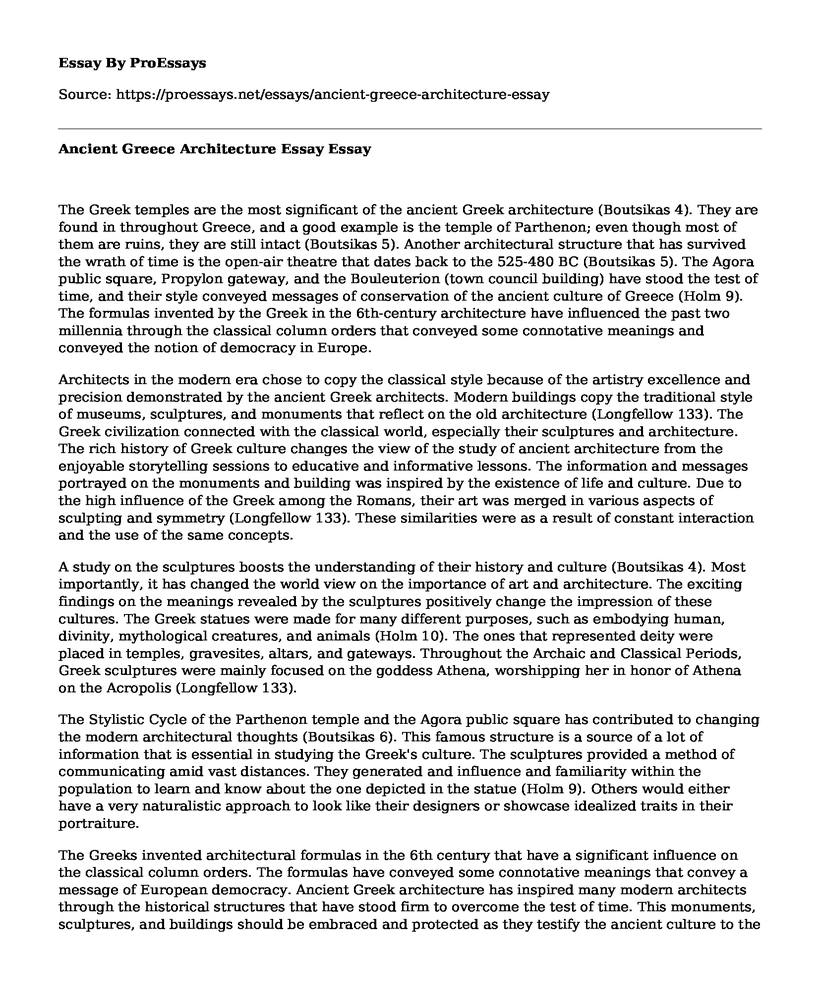The Greek temples are the most significant of the ancient Greek architecture (Boutsikas 4). They are found in throughout Greece, and a good example is the temple of Parthenon; even though most of them are ruins, they are still intact (Boutsikas 5). Another architectural structure that has survived the wrath of time is the open-air theatre that dates back to the 525-480 BC (Boutsikas 5). The Agora public square, Propylon gateway, and the Bouleuterion (town council building) have stood the test of time, and their style conveyed messages of conservation of the ancient culture of Greece (Holm 9). The formulas invented by the Greek in the 6th-century architecture have influenced the past two millennia through the classical column orders that conveyed some connotative meanings and conveyed the notion of democracy in Europe.
Architects in the modern era chose to copy the classical style because of the artistry excellence and precision demonstrated by the ancient Greek architects. Modern buildings copy the traditional style of museums, sculptures, and monuments that reflect on the old architecture (Longfellow 133). The Greek civilization connected with the classical world, especially their sculptures and architecture. The rich history of Greek culture changes the view of the study of ancient architecture from the enjoyable storytelling sessions to educative and informative lessons. The information and messages portrayed on the monuments and building was inspired by the existence of life and culture. Due to the high influence of the Greek among the Romans, their art was merged in various aspects of sculpting and symmetry (Longfellow 133). These similarities were as a result of constant interaction and the use of the same concepts.
A study on the sculptures boosts the understanding of their history and culture (Boutsikas 4). Most importantly, it has changed the world view on the importance of art and architecture. The exciting findings on the meanings revealed by the sculptures positively change the impression of these cultures. The Greek statues were made for many different purposes, such as embodying human, divinity, mythological creatures, and animals (Holm 10). The ones that represented deity were placed in temples, gravesites, altars, and gateways. Throughout the Archaic and Classical Periods, Greek sculptures were mainly focused on the goddess Athena, worshipping her in honor of Athena on the Acropolis (Longfellow 133).
The Stylistic Cycle of the Parthenon temple and the Agora public square has contributed to changing the modern architectural thoughts (Boutsikas 6). This famous structure is a source of a lot of information that is essential in studying the Greek's culture. The sculptures provided a method of communicating amid vast distances. They generated and influence and familiarity within the population to learn and know about the one depicted in the statue (Holm 9). Others would either have a very naturalistic approach to look like their designers or showcase idealized traits in their portraiture.
The Greeks invented architectural formulas in the 6th century that have a significant influence on the classical column orders. The formulas have conveyed some connotative meanings that convey a message of European democracy. Ancient Greek architecture has inspired many modern architects through the historical structures that have stood firm to overcome the test of time. This monuments, sculptures, and buildings should be embraced and protected as they testify the ancient culture to the modern era and future generations.
Works Cited
Boutsikas, Efrosyni. "Placing Greek Temples: An Archaeoastronomical Study of the Orientation of Ancient Greek Religious Structures." Archaeoastronomy. 21 (2007): 4-19.
Holm, A. "Wisdom from Ancient Greece Music, Sculpture, and Architecture." Sculpture Review. 57.4 (2008): 8-11.
Longfellow, Brenda. "Roman Fountains in Greek Sanctuaries." American Journal of Archaeology. 116.1 (2012): 133-155.
Cite this page
Ancient Greece Architecture Essay. (2022, Mar 09). Retrieved from https://proessays.net/essays/ancient-greece-architecture-essay
If you are the original author of this essay and no longer wish to have it published on the ProEssays website, please click below to request its removal:
- ABBA Band History
- Unconditional Love Song
- The Valley of Love Essay
- The Concept of Government Regulation of Social Media Paper Example
- Essay Example on Cast Away: Five Years of Survival in an Unoccupied Island
- Saving Mr. Banks - Movie Analysis Essay
- Sturgill Simpson: Singer, Songwriter, Grammy Winner, Mercury in Retrograde - Essay Sample







